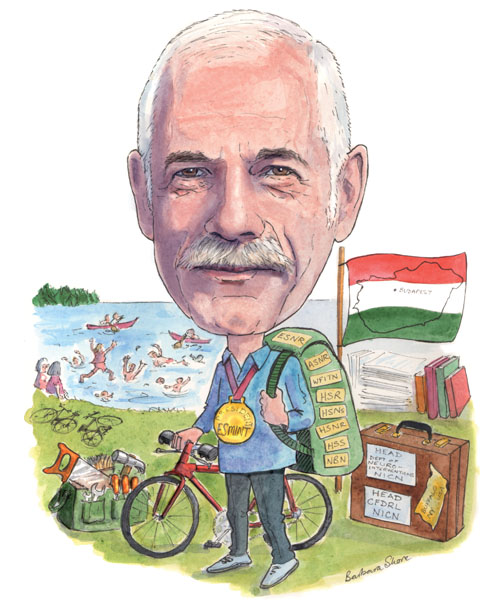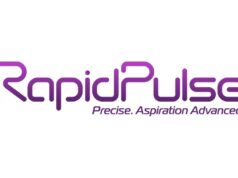
What drew you to medicine and neuroradiology in particular?
Two great people, each of them had a major role in the direction my life took.
I graduated from a church school and spent my high school years in a 900-year-old monastery. My biology professor, a Benedictine monk, was not only a good teacher but a true mentor and a spiritual leader. No wonder, I fell in love with biology under his influence and wanted to be a researcher. However, he knew me better and advised I go to medical school as he was convinced that medicine would better fit my personality. I did not even question his advice. Now I know how perfect it was.
He was no longer around when I graduated from Medical School and I was quite unsure of which specialty to take. Finally, I started my career in Anaesthesiology and Intensive Therapy, trying to combine my interest in science and technology as well as inactive, manual medicine. In seven years, I suddenly burned out and felt an urge to change. I got a chance to restart as a resident in neurosurgery. At that time, in 1984, I did have a remote interest in the first experiments in what is called interventional neuroradiology today. During the three months rotation in Neuroradiology, my mentor and later boss, the head of the neuroradiology department, confirmed that indeed there was a great future in interventional neuroradiology. This was the last time I switched my career path.
Who were your mentors and what wisdom did they impart to you?
As I worked in different fields, I had opportunities to learn from many great people. These include my first boss in anaesthesiology, my professors and colleagues in neurosurgery, neuroradiology and neurointerventions, both here in Budapest and in Buffalo, New York, USA, where I had a chance to spend some years in the early 1990s. I have learned a great deal everywhere, but if you are interested in wisdom, that is: to remain a physician and a human being in between science, technology, finances and politics.
Which innovations in neuroradiology have shaped your career?
No doubt, the role of flow dynamics in the pathogenesis and treatment of aneurysms. I first got exposed to this in Buffalo by my friend, Ajay Kumar Wakhloo in the early 1990s. I am very fortunate to be able to see how flow modification has become part of the clinical practice in 20 years.
Please describe one of your most memorable cases.
It is difficult to choose one. Let me give you a more general answer. Once, a patient told me upon discharge: “Doctor, having this disease is not a good thing, but I am fortunate as this brought me to you.” Can anything be more memorable than these words?
As president of ESMINT, where and how do you see the society growing in the future?
Today we are living in a professional revolution. With all the great advancements in the ischaemic stroke field our job is changing very quickly. We are moving from treating a few cases of rare and interesting diseases, such as aneurysms, or arteriovenous malformations, to effectively treating a very frequent and devastating disease, acute ischaemic stroke. Neurointerventionists must grow to a second level and from a small elite group must become a very strong and powerful community. The role of ESMINT is to help to shape these changes, making sure that by growing we are not losing the spirit that makes us love this job.
What are the highlights of ESMINT’s 2015 annual meeting?
ESMINT is a multidisciplinary society. For years, we have organised our congress together with the Vascular Section of the European Neurosurgical Society (EANS) as well as with the European Stroke Organisation (ESO). This year’s highlight is again the collaboration with our colleagues in the neuro field. Of course, one can not avoid having stroke in the focus. Understanding the great responsibility we have with all of the good results in the neurointerventional treatment of acute stroke, we intend to find the best directions of how to properly train physicians and guide practice in acute stroke treatment.
You have been involved in many studies into aneurysm treatment throughout your career. In your opinion, what has been the greatest advancement, and how do you see it developing in the future?
Undoubtedly, flow modification. There are still lots of unresolved issues. Some of them are fascinating, others frustrating. Briefly, if we can find a way of accurately predicting the results of certain type of flow modifying treatment for certain aneurysms, and reduce the need for aggressive antiaggregation, this method will have a further increasing role.
What is your role as head of the Cerebrovascular Flow Dynamics Research Laboratory at the National Institute of Clinical Neurosciences?
Well, I mentioned at the beginning that as a high school student, I wished to become a scientist. I am glad I did not go in this direction as I feel very good being a practicing physician. But I still have interest and desire in science—I mean practical science. The Cerebrovascular Flow Dynamics Research Laboratory is a strong and fruitful collaboration between great engineers from the Budapest University of Technology and Economics, my colleagues in the Department of Neurointerventions at the Institute, enthusiastic medical students and engineers from imaging companies. What is my role? I am afraid I can not do such research by myself any longer. But I can keep this joint effort running and this greatly satisfies my desire to be active in research.
As a trainer of young doctors, how would you describe your teaching style?
My teaching style? Well, I am not teaching basic science, but rather practical medicine. In my view, the best you can do is to let your young colleagues be a part of your professional (and to some extent, private) life so that they can share your failures and successes equally.
How do you see the field of neuroradiology developing in the future?
As I said earlier: with the acute stroke, neurointervention is becoming the sort of “mass production” instead of the ever fascinating job of a few fanatic pioneers. It is our generation’s job to cope with these changes, making sure that instead of getting lost, the spirit is being multiplied in a much larger community.
What advice would you give to neuroradiologists just starting out in the field?
Focus on neurointerventions, become a neurointerventionist.
What are your interests outside of medicine?
Inside or outside, I live my life in my family. My wife and I are blessed having six children, all grown up now. We are expecting our ninth grandchild very soon. My primary interest is being among them. For my spare time, we all love being outdoors: hiking, biking, skiing, swimming, canoeing, whatever is out in nature and being together. I also love working around the house—I am quite a handyman—which belongs to family, too.
Fact File
Current position
Head of the Department of Neurointerventions and Head of the Cerebrovascular Flow Dynamics Research Laboratory at the National Institute of Clinical Neurosciences, Budapest, Hungary
Education and career
1970–1977 Semmelweis University Medical School, Budapest—Medical degree, graduated cum laude
1981 Board exam in Anaesthesiology and Intensive Care
1988 Board exam in Radiology
1999 Semmelweis University Medical School, Budapest—Ph.D. Degree in Medical Radiology
2001 Board exam in Neuroradiology
2007 Habilitation: Semmelweis University Medical School, Budapest
Previous jobs:
1991–1994 Research Assistant Professor, Department of Neurosurgery, State University of New York at Buffalo (SUNYAB), Buffalo, NY, USA
2005–2007 Deputy Director, General, National Institute of Neurosciences (NIN)
Professional achievements:
Publications in Hungarian journals: 15
Publications in international journals: 74 (cumulative impact factor: 66.3, citation index: 3470)
Abstracts published in cited journals: 21
Book chapters in Hungarian books: 3
Book chapters in international books: 2
Professional affiliations
President, European Society of Minimally Invasive Neurological Therapy (ESMINT)
Member, European Society of Neuroradiology
Member, American Society of Neuroradiology
Member, World Federation of Interventional and Therapeutic Neuroradiology
Member, Hungarian Society of Radiology
Member, Hungarian Society of Neurosurgery
Member, Hungarian Society of Neuroradiology
Member, Hungarian Stroke Society
Member, National Board of Neurosurgery













